After declining somewhat in the past few decades, noise-induced hearing loss (NIHL) is on the rise again. About 10% of Millennials and 17% of Gen-Z have NIHL—a troubling statistic, especially considering that Gen-Z is younger, yet has more hearing loss.
October is Protect Your Hearing Month, so we wish to share some information about NIHL, its causes, and how to keep yourself safe from it. NIHL is permanent but completely preventable, so let’s learn about how to keep our hearing ability long into the future.
About NIHL
Many people imagine that sound needs to be at a painful level in order to cause hearing loss, but this is simply not true. In fact, sound levels as low as 85 dBA (about the noise level of a leaf blower) will cause hearing loss after about 8 hours of continuous exposure.
For every 3 dBA of additional noise, the safe time of exposure is cut in half. This means by the time we get to 100 dBA, hearing loss sets in after only 15 minutes. 100 dBA is about the sound level of an average high school dance or riding a motorcycle. At 110 dBA, a person will incur permanent hearing loss after only 2 minutes. That’s the noise level at most rock concerts and some sports events.
NIHL and Personal Listening Devices
Personal listening devices (PLDs) are one of the biggest causes of hearing loss around the world. The actual noise level that people experience when listening to PLDs is difficult to measure since the sound goes directly from a set of headphones or earbuds into our ears.
One thing we know for sure is that the maximum volume on most modern PLDs is never safe. When Sony released the first Walkman in 1979, warnings about unsafe listening levels followed quickly as people started to experience hearing loss from listening at maximum volume. The maximum volume of today’s PLDs is significantly higher than the original Walkman was capable of producing.
Preventing NIHL from PLDs
Whatever listening device you might be using, set the volume so it is just loud enough that you can hear the material clearly. Do this by starting with the volume low, and turning it up until you can hear well enough.
When possible, over-the-ear headphones are the safest type to use. Earbuds or in-ear headphones, where the speakers are actually in the ear canal, are more likely to cause hearing loss. Over-the-ear headphones also create a seal around the ear, which can help to minimize outside noise, making it easier to keep the volume lower on your PLD.
If you spend a significant amount of time listening while traveling, a set of noise-canceling headphones may be a good investment. These headphones use built-in microphones and active technology to reproduce an out-of-phase signal of the environmental sound, effectively canceling it by the time it reaches the ear. They work extremely well for very continuous sounds, like the noise we experience on airplanes, busses, and long car rides.
If you tend to listen for long periods at a time, take a 15-minute break every hour or so. This will allow your ears to reset and help prevent the kind of hearing loss that can happen at lower volumes after long periods of exposure.
Earplugs
We can’t always avoid dangerous sound levels in the environment. That’s where hearing protection like earplugs can come in. It’s good practice to carry a set of earplugs with you at all times, in case you encounter a situation where they’ll be important.
Types of Earplugs
It’s a good idea to find the right earplugs for you. If you don’t like your earplugs, you’ll be less likely to use them when it’s important, so make sure they’re comfortable, provide adequate protection, and that you don’t mind the way things sound when you’re wearing them.
Disposable
Disposable earplugs are usually made out of foam. You compress the foam, insert them in your ear, and when the foam expands, they hold themselves in place while also blocking a great deal of environmental sound. They cost around $1.00 per pair but may only be used once. They attenuate high frequencies much more than low ones, which can be unpleasant for music listening and can make it harder to understand speech.
Reusable
Reusable earplugs are a step up from disposables. They tend to cost around $15–30, and they attenuate sound more evenly. They tend to be made out of silicone and are relatively easy to put in and take out.
Custom-Molded
Custom-molded earplugs are the most comfortable, most effective, and best-sounding option among earplugs. They fit your specific ear canals perfectly and are loaded with an attenuator that is specifically designed to attenuate for your favorite activities. They preserve the natural relationship between frequencies nearly perfectly, making them the best choice for musicians and regular concertgoers. They are significantly more expensive than the other types, costing as much as a few hundred dollars, but for those who wear earplugs on a regular basis, they are well worth the expense.
This month, take some time to think about your hearing and the times in your life when you might do a better job of protecting your ears. If you’re due for a hearing test, make an appointment to find out the state of your hearing ability and start keeping track of your hearing health!

